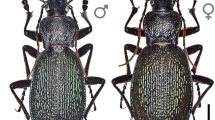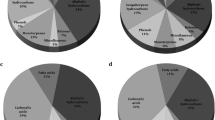Abstract
Three adult cave-dwelling ground beetle species were induced to discharge secretions of their pygidial glands into vials. Dichloromethane extraction was used to obtain the secretions. In total, 42 compounds were identified by GC/MS analysis. Pheggomisetes ninae contained 32 glandular compounds, Laemostenus (Pristonychus) punctatus 13, whereas Duvalius (Paraduvalius) milutini had nine compounds. Caproic, oleic, palmitic, and stearic acids were present in the samples of all analyzed species. Undecane was predominant in the extract of L. punctatus. Palmitic acid was the major component in the secretion of D. milutini. Finally, the most abundant compounds in P. ninae secretion were heptacosene and nonacosadienes. Herein, we present the first data on the identification of pygidial gland secretion components in both troglophilous and troglobite cave-dwelling ground beetles. Some compounds are reported for the first time in the secretions of ground beetles and other higher or lower taxa. The adaptation to underground life has not led to a reduction or changes in the chemical defense mechanism in the analyzed troglophilous and troglobitic Platyninae and Trechinae taxa.

Similar content being viewed by others
References
Blum MS (1981) Chemical defenses of arthropods. Academic Press, New York
Bonacci T, Brandmayr P, Zetto T, Perrotta ID, Guarino S, Peri E, Colazza S (2011) Volatile compounds released by disturbed and undisturbed adults of Anchomenus dorsalis (Coleoptera, Carabidae, Platynini) and structure of the pygidial gland. ZooKeys 18:13–25. doi:10.3897/zookeys.81.1122
Culver DC, Pipan T (2009) The biology of caves and other subterranean habitats. Oxford University Press, Oxford
Giglio A, Brandmayr P, Dalpozzo R, Sindona G, Tagarelli A, Talarico F, Zetto-Brandmayr T, Ferrero EA (2009) The defensive secretion of Carabus lefebvrei Dejean, 1826 pupa (Coleoptera, Carabidae): gland ultrastructure and chemical identification. Microsc Res Techniq 72:351–361. doi:10.1002/jemt.20660
Giglio A, Brandmayr P, Talarico F, Zetto T (2011) Current knowledge on exocrine glands in carabid beetles: structure, function and chemical compounds. ZooKeys 100:193–201. doi:10.3897/zookeys.100.1527
Lečić S, Ćurčić S, Vujisić L, Ćurčić B, Ćurčić N, Nikolić Z, Anđelković B, Milosavljević S, Tešević V, Makarov S (2014) Defensive secretion in three ground-beetle species (Insecta: Coleoptera: Carabidae). Ann Zool Fenn 51:285–300. doi:10.5735/086.051.0301
Makarov SE, Vujisić LV, Ćurčić BPM, Ilić BS, Tešević VV, Vajs VE, Vučković IM, Mitić BM, Lučić LR, Đorđević IŽ (2012) Chemical defense in the cave-dwelling millipede Brachydesmus troglobius Daday, 1889 (Diplopoda, Polydesmidae). Int J Speleol 41:95–100. doi:10.5038/1827-806X.41.1.10
Moore BP (1979) Carabid beetles: their evolution, natural history and classification. In: Erwin TL, Ball GE, Whitehead DR (eds) Chemical defence in carabids and its bearing on phylogeny. Dr. W. Junk, London, pp 193–203
Schildknecht HW (1970) The defensive chemistry of land and water beetles. Angew Chem Int Ed 9:1–9. doi:10.1002/anie.197000011
Schildknecht H, Maschwitz U, Winkler H (1968a) Zur Evolution der Carabiden-Wehrdrüsensekrete Über Arthropoden-Abwehrstoffe XXXII. Naturwissenschaften 55:112–117. doi:10.1007/BF00624238
Schildknecht H, Winkler H, Maschwitz U (1968b) Vergleichend chemische Untersuchungen der Inhaltsstoffe der Pygidialwehrblasen von Carabiden. Über Arthropoden-Abwehrstoffe XXXI. Z Naturforsch B 23:637–644. doi:10.1515/znb-1968-0512
van Den Dool H, Kratz PD (1963) A generalization of the retention index system including linear temperature programmed gas-liquid partition chromatography. J Chromatogr 11:463–471. doi:10.1016/S0021-9673(01)80947-X
Will KW, Attygalle AB, Herath K (2000) New defensive chemical data for ground beetles (Coleoptera: Carabidae): interpretations in a phylogenetic framework. Biol J Linn Soc 71:459–481. doi:10.1006/bijl.2000.0456
Will KW, Gill AS, Lee H, Attygalle AB (2010) Quantification and evidence for mechanically metered release of pygidial secretions in formic acid-producing carabid beetles. J Insect Sci 10:1–17. doi:10.1673/031.010.1201
Acknowledgments
The study was financially supported by the Serbian Ministry of Education, Science, and Technological Development, Grants 173038, 172053 and 173027. We are grateful to Prof. Dr. Vladimir Tomić (Institute of Zoology, University of Belgrade - Faculty of Biology), who helped us with some of the photographs.
Author information
Authors and Affiliations
Corresponding author
Rights and permissions
About this article
Cite this article
Vesović, N., Ćurčić, S., Vujisić, L. et al. Molecular Diversity of Compounds from Pygidial Gland Secretions of Cave-Dwelling Ground Beetles: The First Evidence. J Chem Ecol 41, 533–539 (2015). https://doi.org/10.1007/s10886-015-0593-7
Received:
Revised:
Accepted:
Published:
Issue Date:
DOI: https://doi.org/10.1007/s10886-015-0593-7




